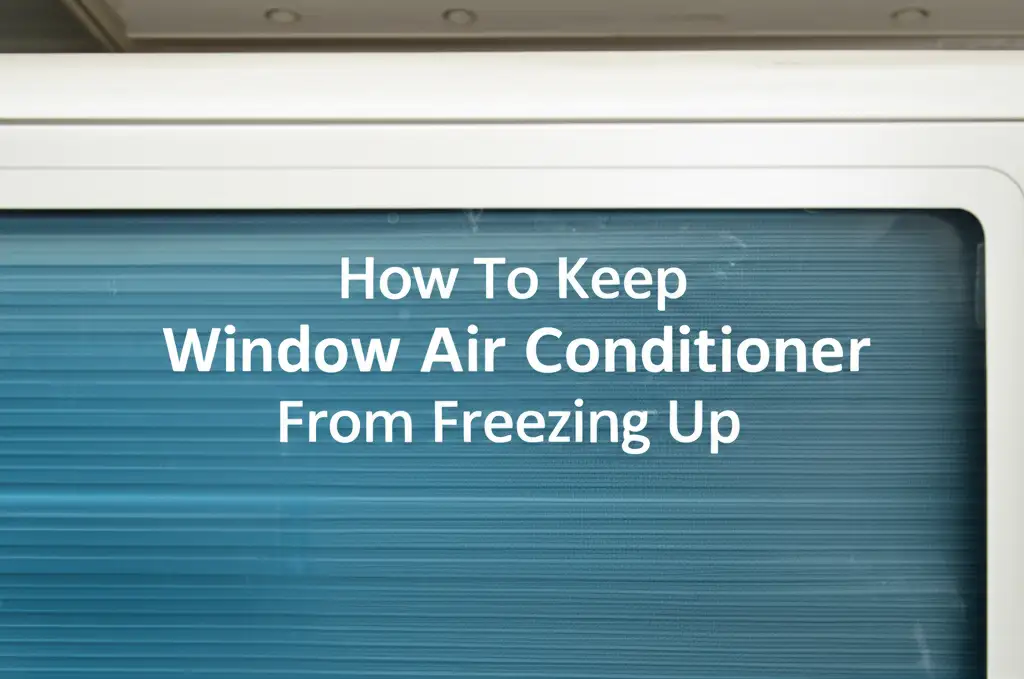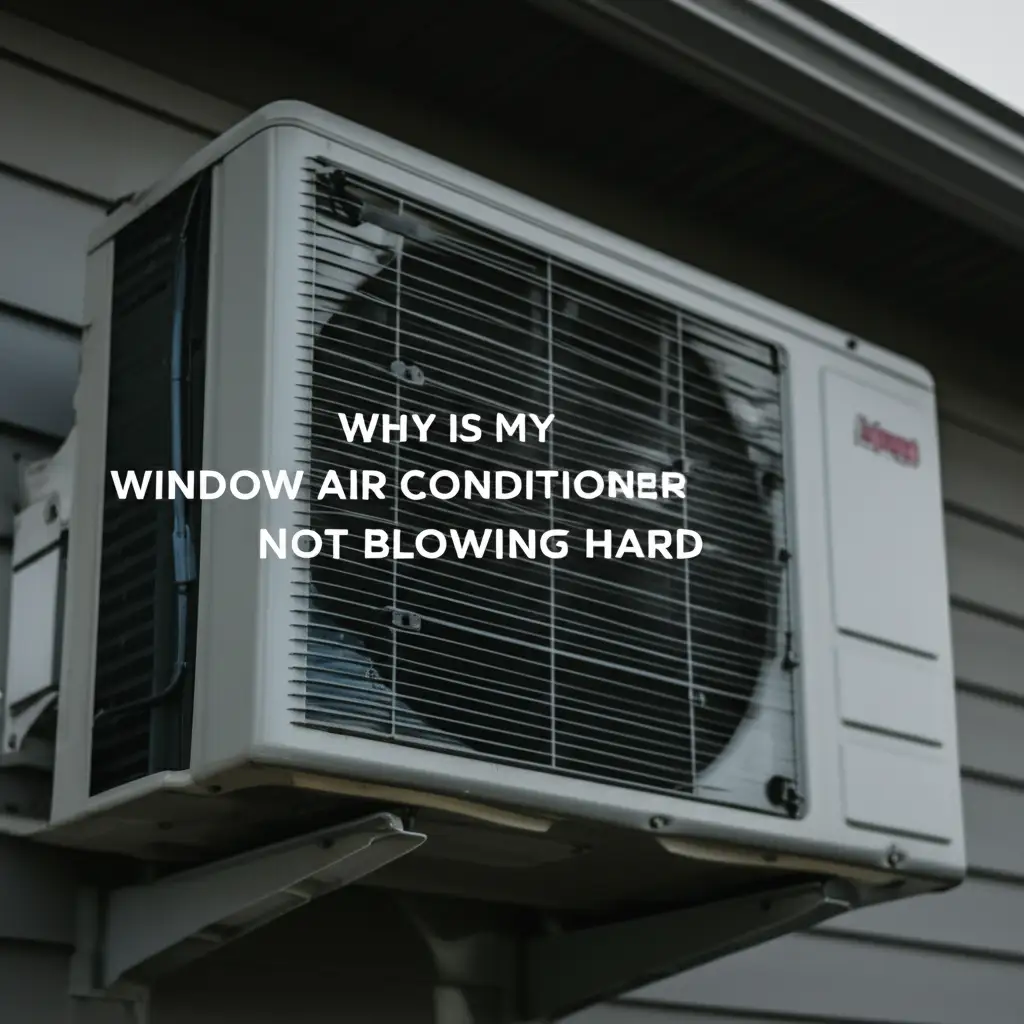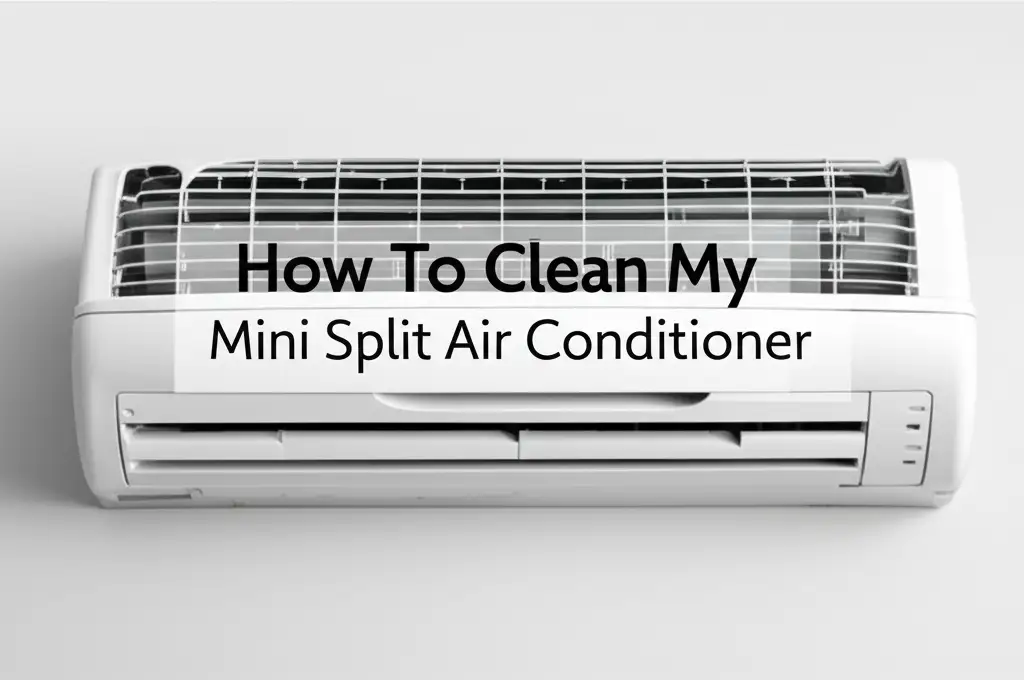· Davia Murnell · AC Maintenance · 16 min read
How To Keep Window Air Conditioner From Freezing Up

Preventing Window Air Conditioner Freezing: Your Guide to Consistent Cooling
Imagine this: The sun beats down, a sweltering summer day demands cool air, but your trusty window air conditioner stops working. You look closer and see it—a solid block of ice forming on the coils. This common problem, a frozen window AC unit, frustrates many homeowners. It stops your unit from cooling properly and can even cause damage.
Knowing how to keep window air conditioner from freezing up is important for comfort and unit longevity. This guide will help you understand why your AC freezes. We will cover practical steps to prevent ice buildup. You will learn easy maintenance tasks and troubleshooting tips. Let us make sure your home stays cool and comfortable all season long.
Takeaway
Keeping your window air conditioner from freezing up involves consistent maintenance and smart usage.
- Regularly clean or replace the air filter.
- Ensure good airflow around the unit.
- Check for proper refrigerant levels.
- Maintain evaporator coils and condenser fins.
- Use appropriate temperature settings.
Direct Answer
To keep a window air conditioner from freezing up, regularly clean or replace the air filter, ensure unrestricted airflow, maintain clean coils, and set the temperature above 70°F (21°C). Addressing low refrigerant levels or thermostat issues with professional help also prevents ice buildup.
Understanding Why Your Window AC Freezes
Many people wonder, “Why does my window air conditioner keep freezing up?” A window air conditioner freezes when the evaporator coil gets too cold. The evaporator coil absorbs heat from your room. If airflow over this coil is restricted, or if the refrigerant pressure is too low, the coil temperature drops below freezing. Moisture in the air then condenses and freezes on the coil. This ice blocks airflow even more.
This creates a cycle of increased freezing. A frozen coil cannot absorb heat effectively. This means your AC unit works harder but produces less cool air. The unit uses more energy and cannot cool your room well. Understanding these causes helps you prevent the problem. We can tackle the core issues before they become major headaches. You can find more details on why this happens in our dedicated article: Why Does My Window Air Conditioner Keep Freezing Up.
Common Causes of AC Freezing
Several factors contribute to a frozen AC. A dirty air filter is a leading cause. This filter blocks airflow. Low refrigerant levels also cause the evaporator coil to get too cold. Restricted airflow from blocked vents or return registers creates the same problem. Even a faulty thermostat or fan motor can play a part. Knowing these causes helps with accurate diagnosis and repair.
Regular Filter Cleaning and Replacement for Optimal Airflow
One of the easiest ways to prevent your window air conditioner from freezing is to maintain a clean air filter. The air filter traps dust, dirt, and pet dander. Over time, this debris builds up and clogs the filter. A clogged filter severely restricts the amount of air passing over the evaporator coil. This reduced airflow causes the coil to get too cold.
When the coil gets too cold, moisture in the air freezes on its surface. This forms ice, which further blocks airflow. I always tell people to check their filters regularly, especially during peak cooling season. A clean filter allows air to flow freely. This helps maintain the correct temperature on the evaporator coil. It prevents ice from forming and ensures your unit runs efficiently.
How to Clean or Replace Your Filter
Cleaning or replacing your window AC filter is a simple task. Most window units have a removable filter located behind the front grille.
- Turn off your AC unit: Always unplug the unit from the power outlet before you start. Safety comes first.
- Locate the filter: Open the front panel or grille of your window AC. You will usually find the filter sliding into a slot.
- Remove the filter: Gently slide the filter out. Note its orientation so you can put it back correctly.
- Clean the filter: For reusable filters, wash it with warm, soapy water. Rinse it thoroughly and let it air dry completely before reinserting. For disposable filters, simply discard the old one.
- Install a new filter: If your filter is disposable, or if your reusable filter is damaged, install a new one. Make sure the new filter is the correct size and type for your unit.
- Reassemble the unit: Slide the clean or new filter back into its slot. Close the front panel or grille.
I recommend checking your filter at least once a month. Clean or replace it every 2-4 weeks, especially if you use your AC often. If you have pets or allergies, more frequent cleaning may be necessary. This simple step saves you from frustrating frozen AC problems.
Ensuring Proper Airflow Around Your Window AC Unit
Airflow plays a critical role in how your window air conditioner operates. Beyond the filter, the overall circulation of air around and through the unit impacts its ability to cool without freezing. Any obstruction to the vents or the general area around the AC can lead to problems. When air cannot flow freely over the evaporator coils, they get too cold. This temperature drop causes condensation on the coils to freeze into ice.
This ice buildup creates a vicious cycle. The ice further restricts airflow, making the problem worse. This reduces cooling efficiency and can damage the unit. It is vital to ensure nothing blocks the vents or the space around your AC. Proper air circulation helps maintain the correct operating temperature inside the unit. This prevents the coils from reaching freezing points.
Checking and Clearing Airflow Obstructions
Take a moment to inspect your window AC unit and the surrounding area for anything blocking airflow. This quick check can save you from a frozen unit.
- Inspect the front grille: Ensure no curtains, blinds, or furniture block the front panel where the cool air exits. Pull curtains back and ensure furniture sits clear of the unit.
- Check the side vents: Many window units have vents on the sides. Make sure nothing like window treatments or wall hangings covers these.
- Clear the return air path: The unit needs to draw air from the room. Ensure no large objects, like shelves or decorative items, block the return air intake. This is often on the front or sides of the unit.
- Maintain clearance: Give your AC unit a few feet of clear space in front and around it. This allows for optimal air circulation.
I once saw a unit constantly freezing because a heavy set of drapes fully covered the entire front. After simply tying back the drapes, the freezing stopped. Small changes like this make a big difference. Proper airflow ensures your unit can breathe and function correctly. It keeps the evaporator coil at an optimal temperature and prevents ice formation.
Addressing Low Refrigerant Levels in Your AC Unit
Low refrigerant is a serious cause for a window air conditioner to freeze up. Refrigerant is the special chemical that absorbs heat from your home’s air and releases it outside. If your AC unit has a leak, the refrigerant level drops. When there is not enough refrigerant, the pressure inside the evaporator coil drops significantly. This causes the coil to get much colder than it should.
As the coil gets excessively cold, any moisture in the air passing over it quickly turns into ice. This ice buildup on the evaporator coil blocks airflow. A low refrigerant level means your unit cannot cool effectively, even though it runs constantly. This leads to inefficient operation and a lack of cold air. Addressing this issue typically requires professional help.
Signs of Low Refrigerant and What to Do
Recognizing the signs of low refrigerant can help you prevent further damage to your window AC.
- Reduced cooling performance: Your AC runs but does not cool the room as effectively as it used to. The air coming out might feel less cold.
- Hissing or bubbling noises: A refrigerant leak can sometimes produce these sounds as the gas escapes.
- Increased energy bills: Your unit works harder and longer to try and cool, leading to higher electricity costs.
- Ice on coils even after cleaning filter: If you have cleaned your filter and ensured good airflow, but ice still forms, low refrigerant is a strong possibility.
If you suspect low refrigerant, do not try to add refrigerant yourself. This is a complex task requiring specialized tools and knowledge. Refrigerants are harmful if not handled properly.
- Turn off the unit: Switch off your AC and unplug it immediately to prevent further damage.
- Call a professional: Contact a qualified HVAC technician. They can safely locate the leak, repair it, and properly recharge the system with the correct type and amount of refrigerant.
A professional can diagnose the issue accurately. They can recharge the system to its proper levels. This restores your unit’s cooling power and stops the freezing. Ignoring a refrigerant leak will only lead to more significant problems and a completely failed unit.
Checking and Calibrating Your Window AC Thermostat
A malfunctioning thermostat can also trick your window air conditioner into freezing. The thermostat is the brain of your AC unit. It tells the compressor when to turn on and off based on the room’s temperature. If the thermostat is faulty, it might incorrectly sense the room temperature. It could tell the unit that the room is hotter than it actually is.
This causes the AC to run continuously, trying to reach a temperature that is already met or even lower than needed. When the compressor runs too long, the evaporator coil gets excessively cold. This leads to ice formation. A miscalibrated thermostat prevents the unit from cycling off properly. This constant operation without appropriate breaks can overwhelm the system.
Troubleshooting Thermostat Issues
Checking your thermostat and ensuring its accuracy is an important step in preventing freezing.
- Check the temperature setting: Ensure your thermostat is set to a reasonable temperature, generally above 70°F (21°C). Setting it too low, especially on cooler days, can cause freezing.
- Test different modes: Try running the unit on fan-only mode for a while. This helps defrost the coils if they are already frozen. Then, switch back to cool mode.
- Observe cycling: Pay attention to whether your AC unit cycles on and off normally. A unit that runs constantly without stopping, even when the room feels cool, might indicate a thermostat problem.
- Clean the thermostat sensor: Sometimes, dust or debris can accumulate on the thermostat’s temperature sensor. Gently clean it with a soft brush or a blast of compressed air if accessible.
- Consider recalibration or replacement: If you suspect the thermostat is consistently inaccurate, consult your unit’s manual for calibration instructions. For older or complex units, a professional might need to recalibrate or replace the thermostat.
I have found that simply adjusting the temperature setting slightly higher often solves intermittent freezing issues. It gives the unit a chance to cycle off and prevents the coils from getting too cold.
Maintaining the Evaporator Coils and Condenser Fins
Beyond the air filter, the evaporator coils and condenser fins themselves require regular cleaning. These components are vital for your window air conditioner’s heat exchange process. The evaporator coils, located inside your home, absorb heat from the air. The condenser fins, on the outside part of the unit, release that heat outdoors. Over time, both collect dust, dirt, and debris. This buildup acts as an insulating layer.
On the evaporator coils, dirt prevents proper heat absorption. This causes the coil to get much colder than usual. When the coil temperature drops excessively, moisture from the air condenses and freezes onto the dirty surface. On the condenser fins, dirt hinders heat dissipation. This makes the entire system work harder and hotter, contributing to overall inefficiency and potential freezing of the evaporator coil. Regular cleaning ensures these parts can perform their heat transfer function correctly.
Steps for Cleaning Coils and Fins
Cleaning these internal and external components of your window AC unit can significantly improve performance and prevent freezing.
- Turn off power: Always unplug your window AC unit before starting any cleaning. Safety is paramount.
- Access the coils: You will need to remove the unit from the window, or at least carefully open the outer casing. Refer to your owner’s manual for specific instructions on how to safely access the internal components. For a more detailed guide on how to clean an AC unit without removing it, check out: How To Clean Window Air Conditioner Without Removing It.
- Clean the evaporator coils: These are usually located behind the air filter. Use a soft brush attachment on a vacuum cleaner to gently remove loose dirt. For stubborn grime, use a coil cleaner spray specifically designed for AC units. Follow the product instructions.
- Clean the condenser fins: These are on the back of the unit, facing outside. Use a fin comb to straighten any bent fins, which can also impede airflow. Carefully brush away dirt and debris. You can also gently rinse them with a garden hose, ensuring water does not get into electrical components.
- Check for mold: If you notice mold growth on the coils or anywhere else, address it. Mold also restricts airflow and can pose health risks. You can find useful tips in our article: How To Clean Mold From Window Air Conditioner.
- Allow to dry: Ensure all cleaned parts are completely dry before reassembling the unit and plugging it back in.
I make it a point to clean my window unit’s coils at least once a year, usually before the cooling season starts. This preventative measure truly helps avoid unexpected freezing issues and keeps the air fresh. Proper maintenance of these components extends the life of your AC and ensures it runs at peak efficiency.
Setting Your Window AC for Efficient Operation
The way you operate your window air conditioner can greatly influence whether it freezes. Many people think setting the temperature extremely low will cool the room faster. This is a common mistake. Running the unit at a very low temperature, especially on cooler days or at night, makes the evaporator coil work harder to reach that low set point. This pushes the coil’s temperature too low.
When the coil gets excessively cold, moisture in the air condenses and freezes on its surface. This leads to ice buildup. Setting your AC to an appropriate temperature prevents this overcooling. It also allows the unit to cycle on and off naturally. This normal cycling gives the evaporator coil time to warm slightly, preventing ice formation. Smart usage saves energy and prevents freezing.
Optimal Settings to Prevent Freezing
Adjusting your AC settings can make a big difference in preventing ice buildup.
- Maintain a moderate temperature: Set your AC to a comfortable yet reasonable temperature, typically between 70°F and 75°F (21°C and 24°C). This range provides effective cooling without overstressing the system.
- Use the “Auto” fan setting: If your unit has an “Auto” fan setting, use it. This allows the fan to turn off when the compressor cycles off. This prevents air from continually blowing over a cold coil without heat absorption. This pause helps the coil warm slightly and melt any potential ice.
- Avoid running on low fan speed with low temperature: Combining a very low temperature setting with a very low fan speed is a recipe for freezing. Low fan speed means less air moves over the coil. This makes the coil colder.
- Consider “Dry” or “Dehumidify” mode: If your area is very humid, running the unit on a “Dry” or “Dehumidify” mode can remove excess moisture from the air. Less moisture means less potential ice formation on the coils. Use this mode if humidity is the main concern, rather than trying to achieve extremely low temperatures.
- Do not run AC when outdoor temperatures are very low: Operating your window AC when the outside temperature is below 60°F (15°C) can cause freezing. The system is designed to work efficiently in warmer conditions. If you need air circulation in cooler weather, use the fan-only setting.
I have found that simply raising my AC setting by a couple of degrees and using the auto fan mode significantly reduces the chance of freezing. It also saves me money on my energy bill. Small adjustments in how you operate your unit lead to big benefits.
Frequently Asked Questions
Can a dirty filter really cause a window air conditioner to freeze?
Yes, a dirty air filter is a very common cause of freezing in window air conditioners. It restricts airflow over the evaporator coil. This causes the coil to get excessively cold, dropping below freezing point. Moisture in the air then condenses and freezes on the coil, leading to ice buildup and reduced cooling performance.
How often should I clean or replace my window AC filter?
You should check your window AC filter at least once a month, especially during periods of heavy use. Clean reusable filters or replace disposable ones every 2 to 4 weeks. If you have pets, allergies, or live in a dusty environment, more frequent checks and cleaning might be necessary to maintain optimal airflow.
What if my window AC keeps freezing after I clean it?
If your window AC unit still freezes after cleaning the filter, other issues might be present. Possible causes include low refrigerant levels, a malfunctioning thermostat, bent condenser fins, or obstructions to airflow within the unit. At this point, it is best to consult a professional HVAC technician for a proper diagnosis and repair.
Is it safe to run a window AC unit that is freezing up?
No, it is not safe or efficient to run a window AC unit that is freezing up. Continuing to run a frozen unit can cause damage to the compressor. It also leads to extremely poor cooling performance and wastes energy. Always turn off a freezing AC unit, allow it to fully defrost, and then address the underlying cause before restarting it.
Can low outdoor temperatures cause my window AC to freeze?
Yes, running your window air conditioner when outdoor temperatures are too low can cause it to freeze. Most window AC units are designed to operate efficiently when outside temperatures are above 60°F (15°C). Operating below this temperature can lead to the evaporator coil getting excessively cold, causing ice to form.
How do I defrost my window AC unit once it has frozen?
To defrost your window AC unit, first turn off the cooling function and unplug the unit from power. You can then set the fan to “On” (if available) to help melt the ice faster. Alternatively, simply allow the unit to sit turned off for several hours or overnight. Once all the ice has melted, identify and fix the underlying cause before turning the AC back on.
Conclusion
A frozen window air conditioner is a frustrating issue. It impacts your comfort and the unit’s lifespan. By understanding why these units freeze and taking proactive steps, you can ensure smooth operation. We have covered key preventative measures in this guide. These include regular filter cleaning, ensuring proper airflow, and maintaining moderate temperature settings. Addressing issues like low refrigerant or faulty thermostats also protects your unit.
I urge you to adopt these maintenance habits. A little effort goes a long way. Keeping your window air conditioner from freezing up is simpler than you might think. Regular care ensures your unit delivers consistent, efficient cooling. Do not let ice stand in the way of your comfort this summer. Take action today to maintain a cool and comfortable home.
- window air conditioner
- AC freezing
- prevent ice buildup
- AC maintenance
- troubleshooting AC
- window unit problems
- cooling efficiency





